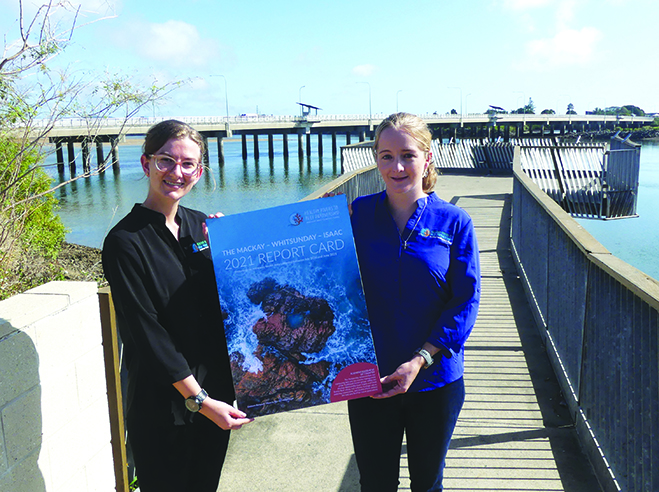


The 2021 Waterway Report Card for the Mackay-Whitsunday-Isaac region was released last week reporting on the health of the region’s waterways from data collected between July 2020 and June 2021.
Chair of the Healthy Rivers to Reef Partnership (HR2RP) Julie Boyd says this year’s report card shows the extent and breadth of the different monitoring programs that inform the results.
“The release of our eighth report card shows great commitment from our partners who continue to support the reporting of waterway conditions in our region,” Ms Boyd said.
“In the 2021 Report Card, we have included the third instalment of cultural heritage assessments, which helps monitor the state of culturally important places and highlight areas requiring maintenance and preservation.
“We’ve also included our urban water stewardship grades which provides an assessment of how local councils manage urban water compared to industry standards and best practice.”
Ms Boyd says a key highlight in this year’s results was the inclusion of seagrass grades for the southern inshore marine zone, which was possible thanks to a partner-led monitoring program.
“The strength of this report card and the partnership is really about the different partners coming together and identifying priorities in both monitoring programs and management actions,” she said.
“The Southern Inshore Monitoring Program is a key example of this, where a priority data gap was identified by the partnership and this monitoring program is now funded by Dalrymple Bay Terminal and Dalrymple Bay Infrastructure.”
HR2RP Executive Officer Dr Bonny Stutsel says that her team was excited to present this year’s report card results to the community and start a conversation about waterway health.
“It’s like when you go to the doctors each year, we keep in check on the conditions of the waterways,” she said.
“We look at our priorities and that comes from two areas: what’s going to make the results more robust or what is the community interest.
“It’s to start a conversation with the community about waterway health instead of just being a big technical report.
“As our sampling and data collection programs become more established, we can start to look at trends over the last five to seven years, and better inform management actions in the region.
“As a whole, the grades across freshwater, estuary, and marine zones remain fairly consistent to previous years, but what sets this report card apart this year is the new data that we’ve included and the opportunities for growth in future programs.
“This year we are reporting on fish in the Don River Basin for the first time, and we’ve also improved some of our sampling and data collection methods for the marine inshore zones.
“We still have data gaps that we would love to fill, such as an estuary monitoring program and improving our flow indicator.
“I think for us as a community, it’s really pesticides that we’re working towards and there’s lots of projects going on with sediment, so bank restoration projects.
“Potential partners have a great opportunity to fill these gaps and help make the report card as robust as it can be.”
The Healthy Rivers to Reef Partnership is supported by the Queensland, Australian and local governments, industry, community and other partners, including the host of the partnership, Reef Catchments.
Download a copy of the 2021 Report Card and supporting technical documents at www.healthyriverstoreef.org.au.
*BREAKOUT BOX*
Key Findings
Overall Highs
• Water Quality: Water quality has remained relatively consistent in freshwater basins and estuaries throughout reporting years, with 11 out of 13 grades remaining unchanged from the 2019-2020 reporting period.
• Seagrass: Seagrass reporting in the Southern Inshore Marine Zone is included for the first time this year, after five years of baseline data collection. In the Northern Inshore Marine Zone, seagrass scores have improved every year since Cyclone Debbie.
• Coral: Coral scores improved in the Central Zone due to increased juvenile recruitment and reduced macroalgae coverage. In the Whitsunday Zone, the decline of coral health following Cyclone Debbie reversed for the first time. This indicates the potential for ongoing recovery providing conditions remain favourable.
• Fish: Scores for freshwater fish were included in the Don Basin for the first time, receiving the highest grade of all basins. The freshwater fish index is a way to measure the number of indigenous fish (native to the region) and non-indigenous fish (non-Australian and translocated Australian species) in the Mackay-Whitsunday-Isaac basins.
Overall Lows
• Water Quality: Pesticides remain the poorest scoring water quality indicator in both freshwater and estuarine systems. Imidacloprid and diuron were the key contributors which are used to suppress pest insects and weeds.
• Water Quality: Water clarity in the Whitsunday Inshore Zone remains an ongoing issue.
• Coral: Coral scores declined in the Southern Inshore Marine Zone driven by residual impacts of the February 2020 marine heat wave.
Rebekah Smith and Dr Bonny Stutsel of Healthy Rivers to Reef Partnership. Photo credit: Sam Gillespie